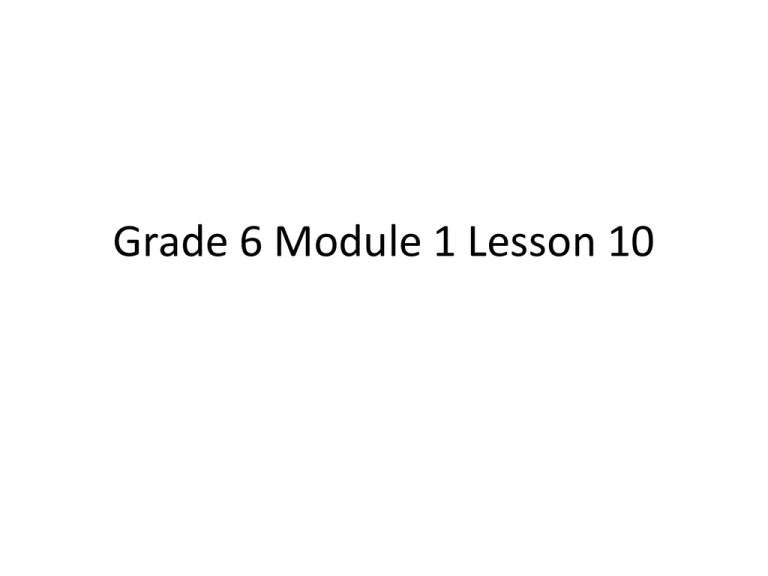Grade 6 Module 1 Lesson 10
advertisement

Grade 6 Module 1 Lesson 10 Exploratory Challenge Imagine that you are making a fruit salad. For every quart of blueberries you add, you would like to put in 3 quarts of strawberries. Create 3 ratio tables that show the amount of blueberries and strawberries you would use if you needed to make fruit salad for greater numbers of people. Exploratory Challenge Table 1 should contain amounts where you have added fewer than 10 quarts of blueberries to the salad. Table 2 should contain amounts of blueberries between 10 and 50 quarts. Table 3 should contain amounts of blueberries greater than 100 quarts. Exploratory Challenge a. Describe any patterns you see in the tables. Be specific in your description. Exploratory Challenge a. Describe any patterns you see in the tables. Be specific in your description. The value in the second column is always three times as much as the corresponding value in the first column. In the first table, the entries in the first column increases by 1, and the entries in the second column increase by 3. Exploratory Challenge a. Describe any patterns you see in the tables. Be specific in your description. The value in the second column is always three times as much as the corresponding value in the first column. In the second table, the entries in the first column increase by 10, and the entries in the second column increase by 30. Exploratory Challenge a. Describe any patterns you see in the tables. Be specific in your description. The value in the second column is always three times as much as the corresponding value in the first column. In the third table, the entries in the first column increase by 100, and the entries in the second column increase by 300. Exploratory Challenge b. How are the amounts of blueberries and strawberries related to each other? Exploratory Challenge b. How are the amounts of blueberries and strawberries related to each other? The amount of strawberries is always three times the amount of blueberries. (Another response) The ratio of the number of quarts of blueberries to the number of quarts of strawberries is always equivalent to 1:3. Exploratory Challenge c. How are the values in the blueberries column related to each other? Exploratory Challenge c. How are the values in the blueberries column related to each other? Addition repeated throughout. Exploratory Challenge d. How are the values in the strawberries column related to each other? Exploratory Challenge d. How are the values in the strawberries column related to each other? Addition repeated throughout. Exploratory Challenge e. If we know we want to add 7 quarts of blueberries to the fruit salad in Table 1, how can we use the table to help us determine how many strawberries to add? Exploratory Challenge e. If we know we want to add 7 quarts of blueberries to the fruit salad in Table 1, how can we use the table to help us determine how many strawberries to add? We could extend our table until we get to seven in the blueberry column. Exploratory Challenge f. If we know we used 70 quarts of blueberries to make our salad, how can we use a ratio table to find out how many quarts of strawberries were used? Exploratory Challenge f. If we know we used 70 quarts of blueberries to make our salad, how can we use a ratio table to find out how many quarts of strawberries were used? We could start with the ratio 1:3 that was given in the description and then multiply by ten to get 10 and 30. These would be the first values in my table. Then I would count up by tens in the blueberries column and count up by 30s in the strawberries column. Exploratory Challenge How are all three of the tables related? Exploratory Challenge How are all three of the tables related? Each table represents the same ratio of the number of quarts of blueberries to the number of quarts of strawberries, which is 1:3. Exploratory Challenge What operation(s) did you use to determine the values for quarts of blueberries and quarts of strawberries? Exploratory Challenge What operation(s) did you use to determine the values for quarts of blueberries and quarts of strawberries? Adding or multiplying (Elaborate where you used each operation) Exploratory Challenge How is the number of quarts of strawberries related to the number of quarts of blueberries? Exploratory Challenge How is the number of quarts of strawberries related to the number of quarts of blueberries? The number of quarts of strawberries is always three times the number of quarts of blueberries. Exploratory Challenge How are the amounts of blueberries related to each other in the table? Exploratory Challenge How are the amounts of blueberries related to each other in the table? Create a table and explain the pattern Exploratory Challenge How are the amounts of strawberries related to each other in the table? Create a table and explain the pattern Exploratory Challenge How are the two patterns related to each other? Create a table and explain the pattern Exercise 1 The following tables were made incorrectly. Find the mistake that was made, create the correct ratio table, and state the ratio that was used to make the correct ratio table. Exercise 1a Hours 3 5 7 9 Pay in dollars 24 40 52 72 Exercise 1a Hours Pay in dollars Ratio __________ Exercise 1a Hours 3 5 7 9 Pay in dollars 24 40 56 72 Ratio 1:8 Exercise 1b Blue 1 4 7 10 Yellow 5 8 13 16 Exercise 1b Blue Yellow Ratio __________ Exercise 1b Blue 1 4 7 10 Yellow 5 20 35 50 Ratio 1:5 Closing Is there a way to use addition to figure out the next row in a ratio table? Closing Is there a way to use addition to figure out the next row in a ratio table? I can use the ratio to help me use addition to get the next row. For example, if the ratio is 2:5, I can add 2 to the first value and 5 to the second value to get the next row in the table. Closing Is there a way to use multiplication to figure out the next row in a ratio table? If I use multiplication to get the next row in the table, I need to multiply both the x and the y values by the same number. So if the original row says (4,5) and I want to multiply by 3 to get the next row, I would multiply 4x3 and 5x3 to get a row that says (12,15). Lesson Summary Ratio Tables are constructed in a special way Each pair of values in the table will be equivalent to the same ratio. Red 3 6 12 21 white 12 24 48 84 6:24 21:84 1:4 1:4 Lesson Summary You can use repeated addition or multiplication to create a ratio table. There is a constant value that we can multiply the values in the first column by to get the values in the second column. Red white 3x4 6x4 12 x 4 21 x 4 12 24 48 84 Exit Ticket Turn Exit Ticket in the green basket once you are done.









